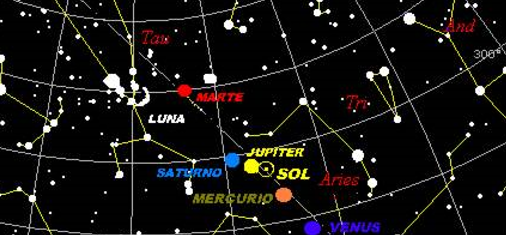Alineación de Venus, Júpiter y la Luna

Estimados hivers, paso a presentarles un fenómeno astronómico que tiene resonancia actualmente como es el de la alineación de planetas.
Se trata de un proceso que se da en el firmamento y que nos hace poder ver a varios planetas en posiciones particulares, presentándose a nuestros ojos como si estuvieran cerca unos de otros formando una línea recta.
Este proceso está asociado al de conjunción de planetas que se refiere al acercamiento de varios planetas que normalmente se muestran separados unos de otros, sin que necesariamente se presenten en línes recta.
En este momento, si miramos hacia el oeste comenzando la noche podemos observar a tres astros alineados: los planetas Venus y Jupiter y junto a estos nuestra luna.

Esta imagen logre captarla con mi smartphone desde San Cristóbal Venezuela, aprovechando la poca nubosidad y la ausencia de electricidad en la ciudad en ese momento, el día 23/03/2023 a las 7:34 pm .
Venus es el que aparece mas abajo y, aunque no se nota en la foto, se mostraba un poco más brillante que Júpiter, en el centro. El mayor brillo de Venus se debe quizás a su cercanía a la Tierra, al ser su vecino, mientras que Júpiter se encuentra mas allá de Marte.
Esta situación planetaria se va a presentar hasta el 2 de marzo y por lo tanto los invito a ver este proceso sobre todo si cuentan con condiciones atmosféricas favorables.
Para ver un fenómeno similar a este habrá que esperar hasta 2025.
Los planetas Venus y Júpiter van a seguir viéndose mas cerca uno del otro en estos días y posiblemente lleguen a aparecer como un solo astro luminoso.
Un dato curioso: el 5 de mayo del año 2000 estuvieron alineados
los planetas Mercurio, Venus, Marte, Júpiter y Saturno, además del sol y la luna, pero no pudieron ser vistos en el firmamento porque casi todos estos planetas estaban detrás del sol y el brillo de nuestro astro principal impidió que esto ocurriera. Aquí les muestro una gráfica publicada por la UNAM sobre la posición de los planetas citados durante ese evento natural.

Que tengan éxito en el avistamiento de este fenómeno astronómico
Fuentes:
- Portada: Imagen de Canva
- Foto de la Alineación planetaria actual: de mi propiedad (tomada en smartphone Blu-G8)
- Translate: DeepL
- http://www.astrosen.unam.mx/~montalvo/alinea2.html
- https://starwalk.space/es/news/planetary-conjunctions#alineaci%C3%B3n-planetaria

Dear hivers, I am going to present you an astronomical phenomenon that has resonance nowadays, the planet alignment. It is a process that occurs in the sky and that makes us be able to see several planets in particular positions, appearing to our eyes as if they were close to each other forming a straight line.
This process is associated with the conjunction of planets which refers to the approach of several planets that are normally shown separated from each other, without necessarily being presented in a straight line. At this moment, if we look to the west at the beginning of the night we can observe three stars aligned: the planets Venus and Jupiter and next to them our moon.

I managed to capture this image with my smartphone from San Cristobal Venezuela, taking advantage of the low cloud cover and the absence of electricity in the city at that time, on 23/03/2023 at 7:34 pm . Venus is the one that appears below and, although not noticeable in the photo, it was a little brighter than Jupiter, in the center. The greater brightness of Venus is perhaps due to its proximity to the Earth, being its neighbor, while Jupiter is beyond Mars. ***This planetary situation will occur until March 2 and therefore I invite you to see this process especially if you have favorable atmospheric conditions ***To see a similar phenomenon we will have to wait until 2025.
The planets Venus and Jupiter will continue to be seen closer to each other in these days and possibly appear as a single bright star. A curious fact: on May 5, 2000 the planets Mercury, Venus, Mars, Jupiter and Saturn were aligned, plus the sun and the moon, but could not be seen in the sky because almost all these planets were behind the sun and the brightness of our main star prevented this from happening. Here I show you a graph published by the UNAM about the position of the planets mentioned during that natural event.

- Cover: Canva image
- Photo of the actual Planetary Alignment: my own (taken on Blu-G8 smartphone)
- Translate: DeepL - - http://www.astrosen.unam.mx/~montalvo/alinea2.html - https://starwalk.space/es/news/planetary-conjunctions#alineaci%C3%B3n-planetaria
Llevo varias tardes-noches viéndolos desde el balcón de mi casa porque todos los días tenemos cielos totalmente despejados y la luna ha estado menguante, creciente en estos días pero apenas una rayita jejeje. Se ve hermosa esa alineación. Saludos!
Qué bueno, yo apenas pude verlos completos el día que tomé la foto, pero el resto de días ha estado nublado y solo se ve la luna.
Congratulations @redactor1918! You have completed the following achievement on the Hive blockchain And have been rewarded with New badge(s)
Your next target is to reach 400 upvotes.
You can view your badges on your board and compare yourself to others in the Ranking
If you no longer want to receive notifications, reply to this comment with the word
STOPTo support your work, I also upvoted your post!
Check out our last posts:
Support the HiveBuzz project. Vote for our proposal!
Gracias por el estímulo
¡Eso es genial @redactor1918! ¡Estamos emocionados de ver tu progreso en Hive! ¡Estamos ansiosos por verte lograr el próximo!
Por cierto, también necesitamos tu ayuda. ¿Podemos pedirle que apoye nuestra propuesta para que nuestro equipo pueda continuar con su trabajo?
Todo lo que necesita hacer es hacer clic en el botón "soporte" en esta página: https://peakd.com/proposals/248.
Thank you!